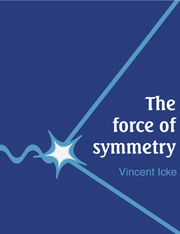Book contents
- Frontmatter
- Contents
- Preface
- Introduction
- 1 A matter of force
- 2 Stalking the wild rainbow
- 3 Light
- 4 Maybe I'm Heisenberg
- 5 Catch a falling quantum
- 6 Quantum beanbags
- 7 Symmetries
- 8 Quantum relativity: nothing is relative
- 9 Life, the Universe and everything
- 10 The physics of a tablecloth
- 11 Colour me red, green and blue
- 12 Smashing symmetry
- 13 How much is infinity minus infinity?
- 14 Excelsior! The ascent to SU(∞)
- A modest reading proposal
- References
- Glossary
- Index
14 - Excelsior! The ascent to SU(∞)
Published online by Cambridge University Press: 05 August 2012
- Frontmatter
- Contents
- Preface
- Introduction
- 1 A matter of force
- 2 Stalking the wild rainbow
- 3 Light
- 4 Maybe I'm Heisenberg
- 5 Catch a falling quantum
- 6 Quantum beanbags
- 7 Symmetries
- 8 Quantum relativity: nothing is relative
- 9 Life, the Universe and everything
- 10 The physics of a tablecloth
- 11 Colour me red, green and blue
- 12 Smashing symmetry
- 13 How much is infinity minus infinity?
- 14 Excelsior! The ascent to SU(∞)
- A modest reading proposal
- References
- Glossary
- Index
Summary
Motives for unification
A snowflake is symmetric, but that does not teach us much about the properties of frozen water. All we observe is that a snowflake has an axis about which it is symmetric under rotations over 60 degrees. We are left guessing about other interesting properties of snowflakes: melting point (it is not 60 degrees!), heat capacity, chemical composition and so forth. But the discussions in the preceding chapters show that the symmetries of the vacuum (Lorentz, U(1), SU(2) and SU(3)) are awfully restrictive and leave precious little room for manoeuvering.
The standard model of these four forces accounts very well for the properties of the observed world. The U(1) theory of quantum electrodynamics is a particularly amazing success, and yet there are some free quantities left. The most nagging of these are the values of the masses of the leptons and quarks; it is especially galling that the masses in the various generations do show a pattern of systematic increase, but it is not orderly enough to allow us to read the underlying mechanism. Also, the extent to which some particles can be superposed into quantum chimaeras (as expressed by the mixing angles) must be derived from experiments.
- Type
- Chapter
- Information
- The Force of Symmetry , pp. 269 - 294Publisher: Cambridge University PressPrint publication year: 1995



